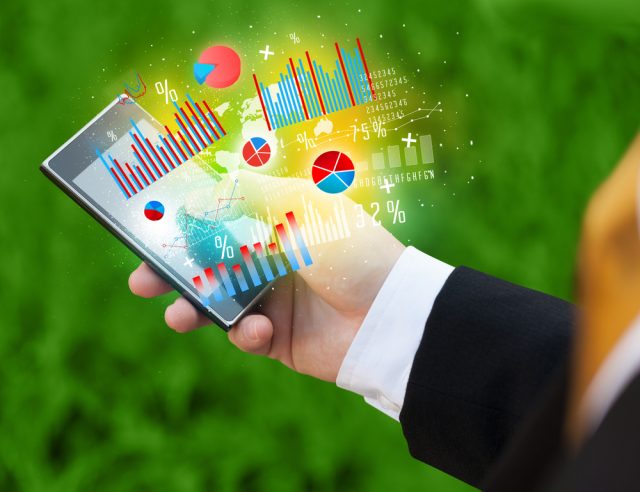The future of business analytics will look similar to your favorite app

Imagine a world where more than 300 million people use analytics to make data-driven decisions every day, decisions that require digging through databases, combining multiple sources of data, and even the most advanced analytics techniques. Don’t believe it? This world already exists. Most of us just don’t know it.
Spotify currently has 381 million users listening to music and podcasts. Netflix just reported that it has 221 million subscribers streaming movies and shows across the globe. It’s estimated that 100 million people use an Apple Watch, and many more millions use other wearable fitness devices as well. The list goes on. These companies help millions of people discover new artists, find a show to watch, and even live healthier lives. Their users are everyday consumers, not business analysts or data scientists, and yet they’re somehow making decisions using insights based on the largest and most complex of data sources. If you want to see the future of analytics in business, look to the leading consumer apps.
Smarter decisions through infused analytics
If it seems like consumers of these apps aren’t really using analytics, that’s because they aren’t -- at least not in the way businesses typically talk about analytics. Missing from these apps are standalone dashboards, static charts or any mention of data warehouses. Instead, these apps use data insights to offer informed choices to their end users. What show to watch, what music to listen to, whether we’re on track to meet our daily fitness goals.
Analytics is what makes these decisions possible. Spotify, for example, combines data from a user’s historical listening habits, other users’ with similar musical tastes, and even popular songs recommended anywhere on the internet, in order to offer more relevant songs to listen to. This is an immense amount of data that even the seasoned data analyst would struggle with, but for Spotify, it is done instantly, personalized to each user, and critically, the results are surfaced in the app itself.
This is how every leading consumer app gets millions of people to use data every day to make smarter decisions. They use cutting-edge technology to extract insights from data and then infuse those insights throughout their app. As a result, users simply have the insights they need, in the apps they’re using, often unaware they’re using analytics at all.
Analytics that prescribe action
Another innovative feature of top consumer apps is helping us focus on taking action. Traditional analytics focuses on descriptive analysis and telling us what already happened. More advanced analytics is predictive, using historical data to guess the future. Leading consumer apps go even further, giving us prescriptive, guided analysis with suggestions and recommendations based on the actions we want to take.
Look at smartwatches or fitness trackers, for example. They inform us of how many calories we’ve burned and that given our current rate, we may not make our goal for the day. But they also provide suggestions on what to do as a result: We will hit our goal if we just take a twenty-minute walk.
These devices wouldn’t be nearly as effective if they simply captured data and made it available to query through an analytics tool. They might be useful, but probably not widely adopted, if they provided a standalone dashboard of historical data, viewable through a web portal through a phone or computer. Instead, all the data crunching happens on the smartwatch itself, and the user simply receives a notification of what to do next. As a result, they’ve revolutionized the fitness and health care industries by simply focusing on helping people live healthier lives.
Analytics will help us invent brand new products
The biggest limitation of traditional business analytics is that it is too focused on reporting. Various technologies have come and gone, helping businesses build prettier dashboards, dashboards that are accessible anywhere on any device, or even automatically generated dashboards. These advances made business analytics more efficient to operate, but did nothing to improve the utilization of information. The future of analytics is helping people pick the right action by offering the right insights at the moment they are needed.
This is ultimately what consumer companies get right. They focus on using insights from data to help people make smarter decisions, and not on the data itself. We are finally beginning to see more businesses adopt this consumer approach to analytics, and these companies are not simply in the media and entertainment industry either.
Freckle is an education company helping schools understand student progress. Personica is helping restaurants adapt to becoming online digital businesses. And just two years ago, Ava, a company providing a fertility bracelet powered by analytics, announced that it’s helped 50,000 women become pregnant without invasive treatment. Each company provides a product or service made possible by analytics; each does so by making the analytics seem invisible.
This is the future of analytics, and it is only the beginning.
Photo credit: ra2studio / Shutterstock

Scott Castle is SVP of Product at Sisense. He is an analytics infusion pioneer bringing over 25 years of software development, go to market strategy, product management and strategic partnership experience to his role as SVP of Product at Sisense. Scott is passionate about turning data teams into superheroes that find unexpected insights in big data and disrupt traditional BI. Previously, Scott held technology positions at companies including Adobe, Electric Cloud and FileNet. Scott holds computer science degrees from the University of Massachusetts Amherst and UC Irvine.